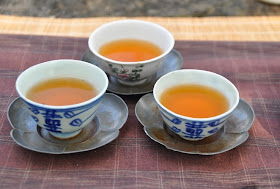Teaparker has published a new book (in Chinese). This one is dedicated to the beauty of old teas. What are the special tastes, fragrances of old tea? What material to use to brew them well? How to appreciate them? And what strategies to adopt to enjoy good old teas?...
One of his best advice is that if you want to drink excellent old tea, the best is to start early to age some yourself!
This is what I started to do in the
winter of 2007 with some roasted luanze Oolong from Lishan! Let's see what it tastes like after 6 years of resting in this white porcelain jar. Initially, I had it sealed with candle wax. This was a good idea to make sure that you keep your hands away from it and don't drink it too quickly! But it's not very convenient to monitor the tea over time. When I opened it for the first time
3 years ago, the wax made quite a mess and I haven't removed it completely for that reason. I don't recommend doing it anymore.
3 years ago, I also removed the plastic foil that was glued to the inside of the jar's lid. All these chemicals (plastic and glue) had an bad impact on the leafs' fragrance at the time. The difference with the tea in the original plastic foil was little. (This was Teaparker's advice that
I had tested then).
As I'm writing this article, I'm remembering this comparison and find the same Lishan leaves stored in the original foil (without vacuum seal). (
Update: this is still the same foil that the farmer used to pack the tea originally, similar to what most merchants use here in Taiwan. I have kept it tightly closed in a carton, in a closet = in a clean and dark place. Both teas were kept in my apartment in Taiwan, exposed to more or less the same temperatures.) The sight of the dry leaves is much different now. The jar stored leaves appear shinier, while those from the foil appear dull. A parallel brewing of the 2 leaves shows that the brew from the foil is a little darker, but not as clear as the leaves from the jar.
The fragrances are from the foil are not as powerful, but they still contain notes of fire (roasting) and feel rather rough. The brew from the jar has evolved away from the nutty notes of roasting towards osmanthus scents and even plum scents.
The major difference is in taste. Stored in foil, the taste is hard, rough, slightly bitter. Stored in porcelain jar, the taste is sweet, refined with sour notes. These sour notes add length to the aftertaste and turn into more sweetness and a nice salivation in the mouth.
The open leaves from the jar appear a little bit more red than the leaves from the foil. This seems to indicate that some post oxidation happens more in the jar than in the foil.
After 6 years of storage, this tea has evolved very differently depending on how it was stored. It either felt rough or heavenly. The jar led to much improvement compared to the foil. This demonstrates that it really makes sense to age your Oolong yourself with a porcelain jar: tea merchants store their teas in plastic foils and vacuum sealed 99.9% of the time.
(Note: I'm making 10 x 15 grams of this jar stored Lishan Hungshui Oolong available for purchase on my selection for people interested in understanding aged Oolong. You'll get the best results with a low leaf ratio and long brewing times. A strong first pour will help open the rolled leaves.)


























































